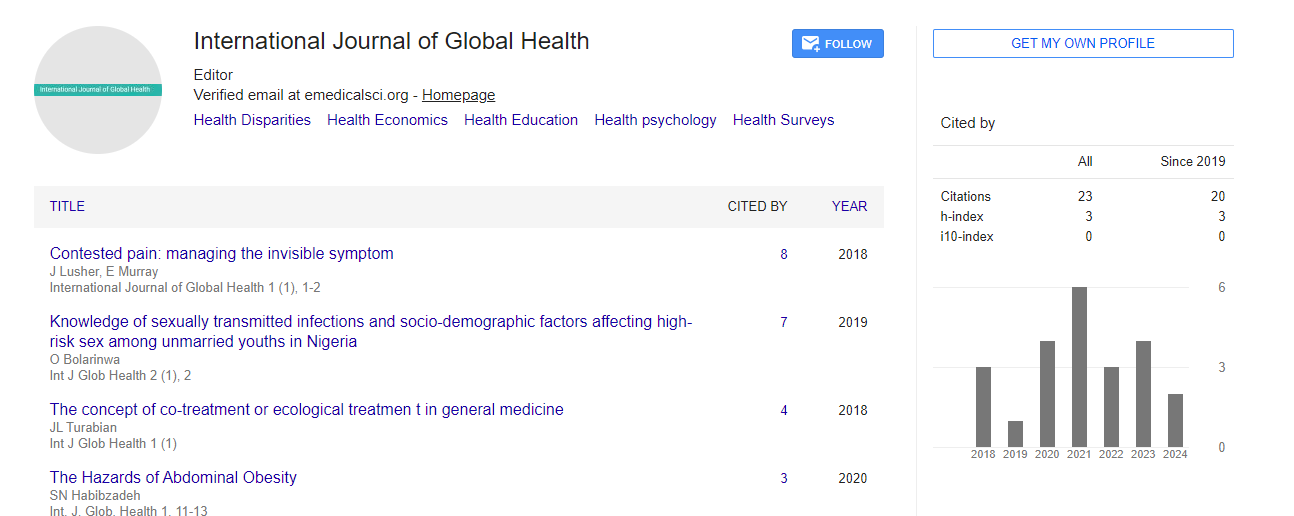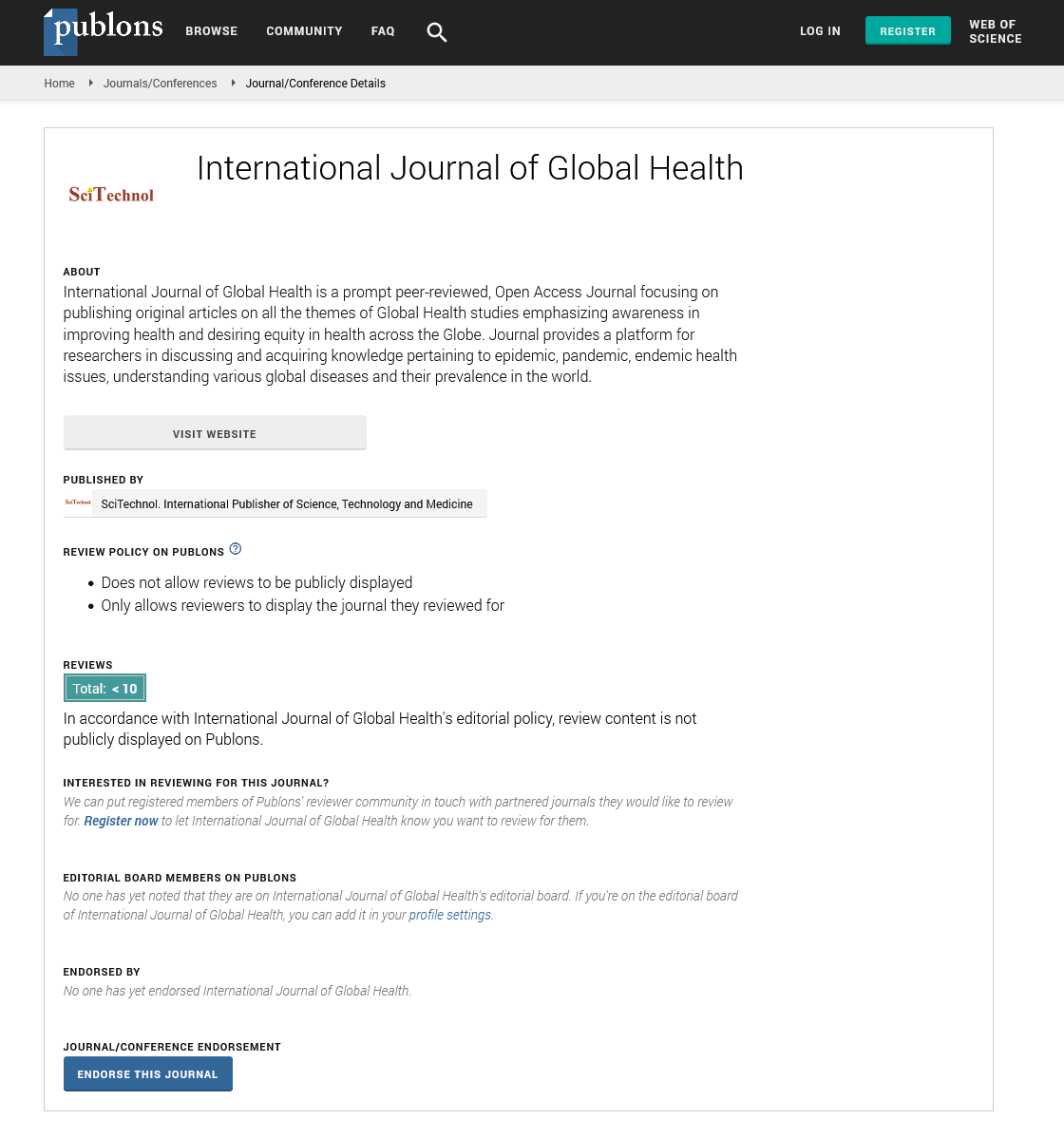Commentary, Int J Glob Health Vol: 6 Issue: 2
COVID-19: Navigating the Pandemic and Building a Resilient Future
Bernd Peter*
1 Department of Health Care, University of Queensland, Brisbane, Australia
*Corresponding Author: Bernd Peter,
Department of Health Care, University of Queensland, Brisbane, Australia
E-mail: peter@bernad.au
Received date: 24 May, 2023, Manuscript No. IJGH-23-107354;
Editor assigned date: 26 May, 2023, PreQC No. IJGH-23-107354 (PQ);
Reviewed date: 09 June, 2023, QC No. IJGH-23-107354;
Revised date: 16 June, 2023, Manuscript No. IJGH-23-107354 (R);
Published date: 23 June, 2023 DOI: 10.4172/Ijgh.1000180
Citation: Peter B (2023) COVID-19: Navigating the Pandemic and Building a Resilient Future. Int J Glob Health 6:2.
Description
The COVID-19 pandemic has had an unprecedented impact on the global community, transforming lives and societies in profound ways. This study delves into the multifaceted nature of the pandemic, highlighting its origins, transmission, impact on public health and economies, the global response, and the lessons learned as one strives to build a resilient future.
Origins and transmission
COVID-19, caused by the novel coronavirus SARS-CoV-2, was first identified in Wuhan, China, in late 2019. It quickly spread across borders, evolving into a global health crisis. The virus primarily spreads through respiratory droplets when an infected person coughs, sneezes, talks, or breathes. It can also spread by touching contaminated surfaces and then touching the face. The ease of transmission, coupled with the virus’s ability to be asymptomatic in some individuals, posed significant challenges in containing its spread.
Impact on public health
The COVID-19 pandemic has had a profound impact on public health systems worldwide. Health facilities became overwhelmed, and healthcare workers faced immense pressure while treating a surge in patients. The virus’s severity varied, with some experiencing mild symptoms, while others faced severe respiratory distress and complications. Vulnerable populations, including the elderly and those with pre-existing health conditions, were particularly at risk. As the pandemic progressed, the importance of preventive measures such as wearing masks, practicing good hand hygiene, and maintaining physical distance became evident in reducing transmission rates.
Economic disruptions
Beyond its health impacts, COVID-19 caused significant disruptions to economies globally. Lockdowns, travel restrictions, and business closures aimed to mitigate the virus’s spread but resulted in widespread unemployment, economic recession, and financial strain on individuals and businesses. Industries such as tourism, hospitality, and retail were hit particularly hard. Governments implemented various measures to provide economic relief, including stimulus packages, income support, and business grants. The pandemic highlighted the need for resilient and adaptable economies that can withstand such shocks and support individuals and businesses during crises.
Global response and lessons learned
The global response to COVID-19 involved collaboration, scientific advancements, and rapid policy adjustments. International organizations like the World Health Organization (WHO) played a central role in coordinating efforts, providing guidance, and facilitating information sharing among countries. Vaccines were developed and approved at an unprecedented pace, thanks to global collaboration and accelerated research. However, the pandemic also exposed weaknesses in the preparedness and response systems. Lessons learned include the importance of early detection and surveillance, strong healthcare infrastructure, robust supply chains for medical resources, and effective communication to ensure public trust and compliance with preventive measures.
Vaccine distribution and equity
Vaccines offer a glimmer of hope in the fight against COVID-19, but equitable distribution remains a challenge. Access to vaccines has been unequal, with low-income countries facing significant hurdles in acquiring sufficient doses. Global initiatives like COVAX aim to address this disparity by ensuring fair distribution, but more efforts are needed to bridge the gap. Vaccine hesitancy and misinformation also pose challenges, emphasizing the importance of comprehensive public education and targeted communication campaigns to instill confidence in vaccination programs.
Building a resilient future
As the world recovers from the immediate impacts of the pandemic, it is necessary to build a more resilient future. This includes strengthening healthcare systems, investing in research and development, and enhancing global cooperation. Additionally, one must address the broader socio-economic and environmental factors that contributed to the pandemic’s impact, such as health disparities, urban overcrowding, deforestation, and climate change. By prioritizing sustainable development, fostering international collaborations, and investing in public health infrastructure, one can better prepare for future health crises and mitigate their potential impacts.
Conclusion
The COVID-19 pandemic has reshaped the world, challenging the resilience, adaptability, and capacity to respond effectively. It has underscored the interconnectedness of the global community and the need for collective action to overcome crises. As one navigate the ongoing challenges and work towards recovery, let us learn from the lessons of the past, prioritize public health, and build a future that is more resilient, equitable, and prepared to face any future health threats that may arise.
 Spanish
Spanish  Chinese
Chinese  Russian
Russian  German
German  French
French  Japanese
Japanese  Portuguese
Portuguese  Hindi
Hindi 
